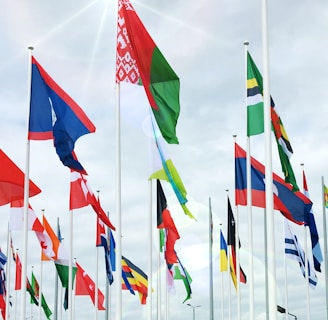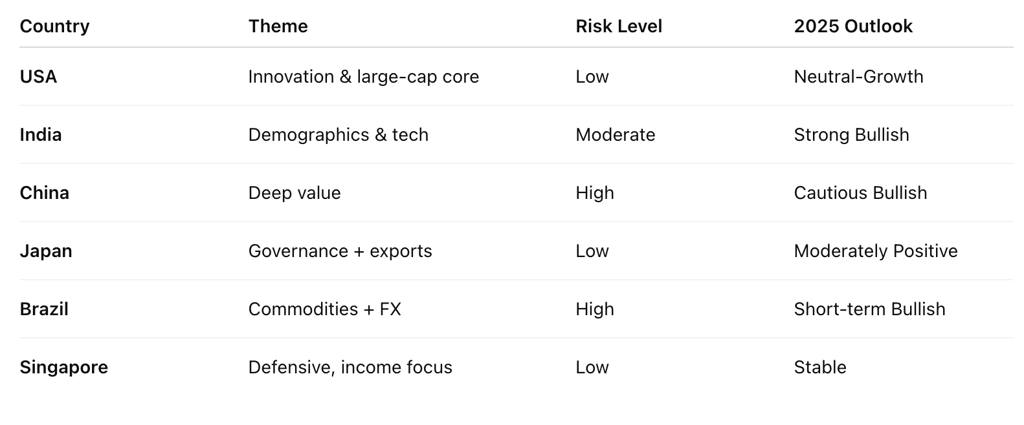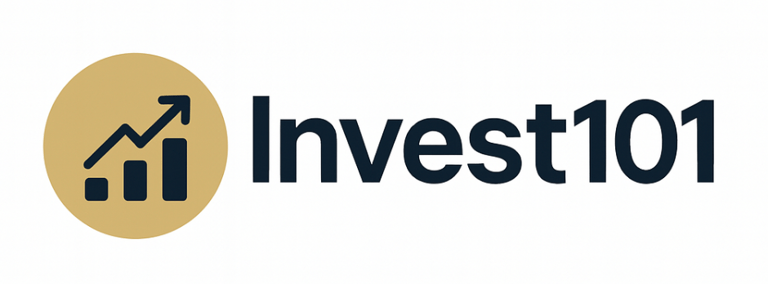Which Country Should You Invest In?
A 2025 Global Market Outlook
7/14/20252 min read


In today’s interconnected world, geographic diversification is more important than ever. With shifting interest rates, geopolitical instability, and uneven growth across economies, choosing which country to invest in is a crucial decision for global investors. The answer depends on your risk tolerance, investment goals, and view of global trends.
Here’s a 2025 overview of promising regions, and the considerations for each.
1. United States: Resilient but Fully Valued
Pros:
World’s most liquid and innovative capital markets
Strong tech and AI leadership (Apple, Microsoft, NVIDIA, etc.)
Dollar strength offers stability
Cons:
Equity valuations remain high (S&P 500 P/E above long-term average)
Interest rate cuts expected, but timing uncertain
Verdict:
Still a core market for long-term growth, especially in tech and healthcare—but consider diversifying beyond mega-cap U.S. stocks.
2. India: Structural Growth Powerhouse
Pros:
Fastest-growing major economy (6–7% GDP growth forecast)
Demographic dividend: young, digital-native population
Government support for manufacturing, digital infrastructure
Cons:
Valuations are no longer cheap
Political concentration and regional risks
Verdict:
A top emerging-market pick. Ideal for long-term investors seeking growth beyond China.
3. China: Undervalued, but Uncertain
Pros:
Extremely low valuations in tech, property, and consumer stocks
Government stimulus is slowly returning
Key global supplier in EVs, renewables, AI chips
Cons:
Structural slowdown in property and exports
Investor confidence remains weak due to regulatory unpredictability
Verdict:
Contrarian opportunity for risk-tolerant investors, especially in A-shares and green tech.
4. Japan: Quiet Comeback Story
Pros:
Corporate governance reforms boosting shareholder returns
Yen weakness supports exports
Rising foreign inflows
Cons:
Aging population and slow domestic consumption
Relatively low innovation compared to peers
Verdict:
A defensive play with upside. Good for income investors via dividend-paying blue chips.
5. Brazil: Commodity & Energy Exposure
Pros:
Strong exports of soybeans, oil, and iron ore
High interest rates support carry trades
Political landscape more stable than recent years
Cons:
Currency volatility
Still sensitive to China and U.S. demand cycles
Verdict:
Attractive for short- to medium-term tactical plays on commodities and EM currency trades.
6. Singapore: Gateway to Asia
Pros:
Financially sound, stable, and well-regulated
Hub for Southeast Asia and wealth management
Strong REIT and infrastructure sectors
Cons:
Slower growth profile vs neighbors
Market size is limited
Verdict:
Good for capital preservation and regional exposure, especially in REITs and dividend plays.
Final Thoughts: How to Choose
Ask yourself:
Do I want growth, income, or stability?
Am I prepared to manage currency risk and political risk?
Will I use ETFs, mutual funds, or direct stock exposure?
Pro tip: Don’t bet on one country. Use country-specific ETFs (like EWZ for Brazil, INDA for India, or EWJ for Japan) to build a diversified global portfolio.


Summary Table:
Invest101.blog
Articles and resources for smart investing.
Contact
contact@invest101.blog
© 2025. All rights reserved.
